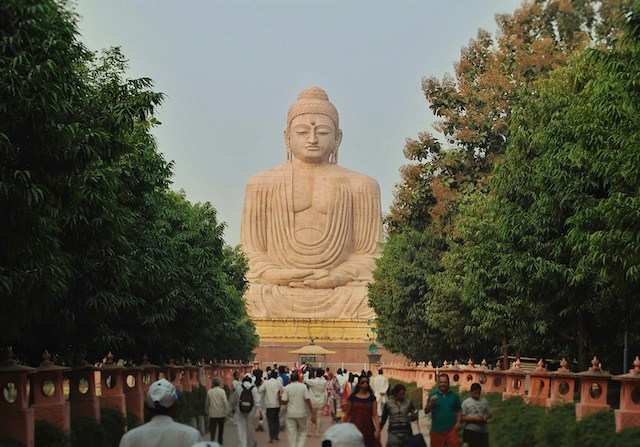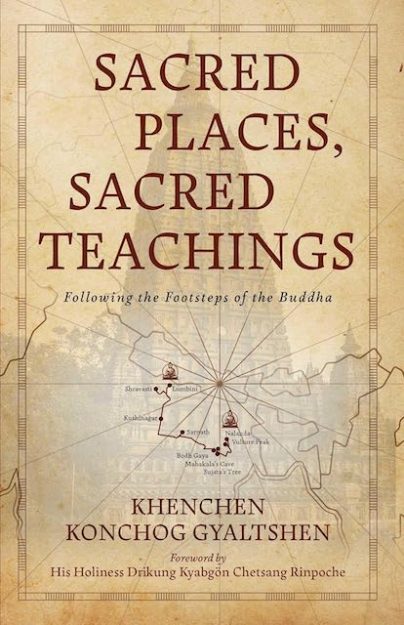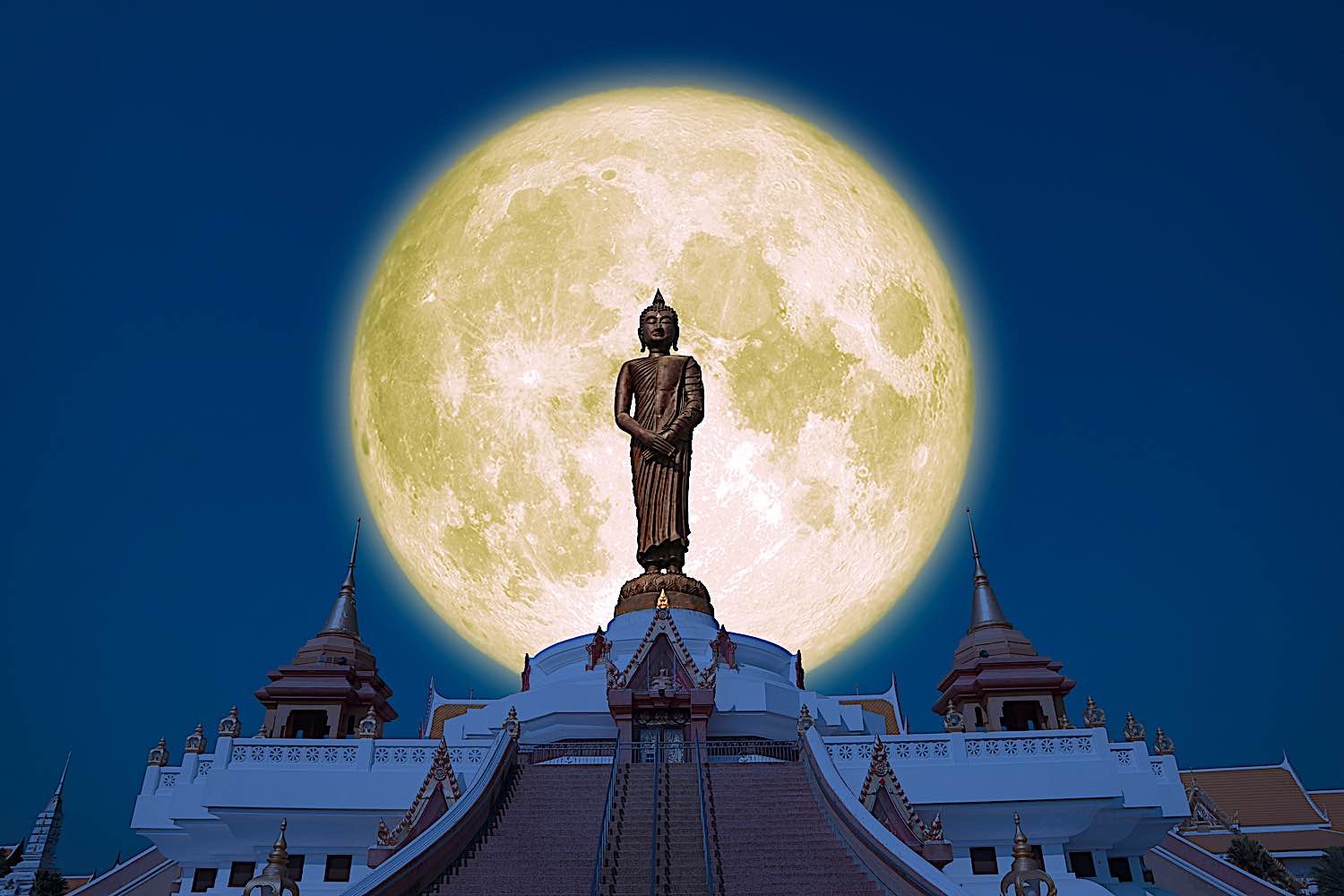Knowing Nirvana
Revisiting the story of the the Buddha’s awakening under the Bodhi tree The post Knowing Nirvana appeared first on Tricycle: The Buddhist Review.

In Buddhist cosmology, Bodhgaya is the strongest, most stable place on earth, the only place that could have supported the Buddha at the moment of enlightenment. It is marked by the Mahabodhi Temple, an imposing tower built and rebuilt on the same spot for millennia. The structure that you see today is a reconstruction begun by Burmese patrons and continued by the British in the 1800s. Improvements continue constantly, such as the addition of a marble circumambulation path and restoration of a railing said to have originated with Nagarjuna in the second century CE. Inside the temple is a statue of the Buddha at the moment of awakening that dates to the 10th century. On the side opposite the temple entrance is a large, old tree. It is not the original Bodhi tree that the Buddha sat under; that one became quite deteriorated and blew over in a storm in 1876. In the third century BCE, King Ashoka’s daughter had taken a cutting from the original tree to Sri Lanka, where it survives. When the tree at Bodhgaya died, a cutting from the Sri Lankan tree was returned and grew into the one we see today. But some say that today’s tree spontaneously regenerated out of the original roots.
Siddhartha’s Journey to Bodhgaya
Before his enlightenment, Siddhartha had been engaged in ascetic practices for some time, and his body had grown weak. After regaining his strength from a meal of milk and rice offered by a local girl named Sujata, Siddhartha walked on to Bodhgaya and seated himself beneath a fig tree on what became known as the vajrasana, or adamantine seat. He knew now that a Middle Path between extreme asceticism and self-indulgence must be traversed. He resolved not to leave that seat until he found final enlightenment, no matter what might happen to his physical form. Thus he began his final meditations in the place where all buddhas awaken.
Mara came to prevent Siddhartha’s enlightenment in every way that he could. He sent his daughters to tempt the bodhisattva with lust, sent murderous armies to attack, and offered to make him ruler of the world, but nothing disturbed Siddhartha’s meditation. Finally, Mara claimed that the seat of enlightenment was his own. Mara’s demons bore witness to his claim and taunted the buddha-to-be by asking where his own witnesses were. Siddhartha silently reached his right hand out to touch the ground, and the earth itself affirmed that he was the Tathagata. Throughout the night, he continued in deep meditation. He acquired the three knowledges: knowledge of past lives, his own and all other beings; knowledge of the operation of karma, or cause and effect; and knowledge that he was truly and completely free of all obscurations and obstacles, that he had pierced through to the ultimate nature of reality. He meditated without further interruption until the last veils of ignorance were cleared away and he attained the vajra-like absorption of buddhahood. At dawn, he proclaimed:
Through many a birth I wandered in samsara,
seeking, but not finding, the builder of the house.
Sorrowful is it to be born again and again.
O house-builder! You are seen.
You shall build no house again.
All your rafters are broken. Your ridgepole is shattered.
My mind has attained the unconditioned.
Achieved is the end of craving.
Bodhgaya is where a prince became the Teacher, where a simple monk became the World Honored One, where one man became the founder of one of the world’s great religions. It is where Prince Siddhartha purified all the gross and subtle obscurations and directly perceived the unfabricated, uncontrived reality of phenomena. From then on, he was called the Buddha, the Fully Awakened One. There are so many religions in this world; it seems almost every country has a different one. Some traditions are more philosophical, where others emphasize practice or devotion. You can describe Buddhism as either a philosophy or a religion, but at its core it is the explanation of the nature of reality, which the Buddha realized at his awakening under the Bodhi tree.
The one we know as the historical buddha, Shakyamuni, was born as Prince Siddhartha, the son of the powerful king Shuddhodana, in the Himalayan mountains. He was brought up in a special way to make him physically and mentally fit to be king. He was taught by the best teachers and given every opportunity to attain all the knowledge that existed at that time. His early life was spent entirely within a well-guarded, luxurious palace. He remained there until he was 29, when he left the palace to visit the kingdom and learn about the lives of common people. It was then that he actually learned the reality of samsara. It was immediately obvious to him that not everyone lived in the luxury he was accustomed to. He encountered poor, uneducated, sick, old, and dying people for the first time.
He saw that they worked hard as farmers or businessmen, that they faced many types of physical suffering and all sorts of predicaments, and that people are victims of mental afflictions, too. These sights caused the prince to think seriously about how to help his subjects. He felt a sincere responsibility to them and was not at all attached to his power, authority, fame, and wealth. When his father noticed this, he feared that the prince might leave the kingdom permanently. He arranged for the prince to take a wife, Yashodhara, in the hope that attachment to her would make him stay. But instead of ascending to the throne, the prince renounced the kingdom and left to search for a way to end the suffering he’d witnessed.
Over the course of the next six years, Siddhartha met many teachers who were famous for their scholarship and meditation practice. He received their teachings, and he exercised his mind by contemplating and meditating according to their instructions. From an extremely luxurious life, he undertook drastic asceticism, even going without food for long periods. Although he achieved a very high state of meditation called the space-like absorption, he felt that there was still more he could achieve. It was then that he arrived in Bodhgaya and sat under the Bodhi tree to meditate. With complete dedication and determination, he vowed, “Even if my body disintegrates, I will remain until I achieve the final goal.” Because of his determination and one-pointed mind, he was able to reveal the nature of the universe; he penetrated to the core of reality and uncovered the universal nature of the mind. Everything about the constitution of reality, the whole of phenomena, was precise and clear. This unfabricated wisdom was accompanied by perfect compassion, which means that all of his obscurations and delusions had totally vanished. From that time on, he was called the Buddha, the Fully Awakened One. To distinguish him from other buddhas, we also know him as Buddha Shakyamuni, with “Shakya” being his family or clan’s name and “muni” being the Sanskrit word for sage.
Bodhgaya is where a prince became the Teacher, where a simple monk became the World Honored One, where one man became the founder of one of the world’s great religions.
This world is permeated by afflicted confusion and suffering—we can all agree on that. Beings suffer from aging, sickness, and dying. They suffer from not getting what they want and from getting what they do not want. For the most part, we have enough food, clothing, and a place to live. But instead of enjoying these good conditions, we create problems for ourselves and others by engaging in confusion, hatred, and greed. These problems cannot be solved by laws and rules, or by becoming wealthier. We need wisdom and compassion to do that, as well as the skill to handle mental confusion. We spend our whole lives chasing happiness and avoiding suffering, to no avail.
All phenomena of samsara and nirvana are constituted within the framework of causality. This reality is not experienced just by Buddhists but rather by every sentient being in the world, human and nonhuman. But from that starting point, there are many different ways to approach and solve this problem of suffering. In fact, because sentient beings have differing levels of mental capacity and different ways of thinking, there are said to be 84,000 types of mental affliction. The Buddha taught ways to comprehend and purify each one of these delusions through what are called the 84,000 heaps of dharma teachings.
The approach in the Buddha’s teachings is not one of blind faith. Rather, we are taught to examine things for ourselves and find solutions to our problems. The Buddha is not a creator of virtue and nonvirtue; rather, he is the guide who shows the path to the end of suffering. He is a teacher who can point out the best direction, but we must travel the path ourselves. We are our own masters. He taught that there are four reliable guideposts. We should make sure that we contemplate them and understand their meaning.
1. Rely on the teaching, not the teacher. Take refuge in the teachings of wisdom and compassion; study and practice them. Having a teacher with a pleasing personality is not as important as the teachings they give.
2. Rely on the ultimate teachings about emptiness and nonduality, not the relative ones. Conventional or relative phenomena are impermanent. As we progress on the path we will have to leave the relative teachings behind. Take the ten bhumis, or stages on the path to enlightenment, as an example. When we arrive at a new level, we must leave the preceding stage behind.
3. Rely on the meaning, not the words. Don’t be attached to beautiful words, but contemplate the meaning of the precious dharma.
4. Rely on wisdom, not mundane consciousness. Wisdom is knowing the unfabricated nature of reality as it is. Consciousness is ever-changing mental activity.
Modern scientists pose questions and, on the basis of their various investigations, find solutions. We appreciate their methods, especially those of quantum physics, because the Buddha’s teaching operates in much the same way. Only it can go farther because it examines the mind. Because the mind is not material, it cannot be found through any machine or medical device, no matter how far modern technology advances. Scientists may be able to examine the brain in great detail, but not consciousness itself. Communication, transportation, the internet, computers, and so forth are indeed very sophisticated, yet they cannot discover the nature of reality. The nature of reality simply cannot be found through the physical methods researchers rely on; it can only be revealed by the consciousness within us. Although close at hand, the mind remains mysterious to us. The Buddha perceived the nature of reality fully and directly, so that nothing was hidden from him. This is what we mean by buddha: a fully awakened mind that knows everything and sees everything clearly.
The Buddha’s Realization
When the Buddha attained buddhahood, he said that he had found an unafflicted nectar that is deeply profound, total peace, free from fabrication, luminous, and unconditioned. That deeply profound thing he found is the mind. Mind is infinite and complex. Mind neither exists nor does not exist. You cannot pinpoint its location, form, color, or weight, so from this perspective, it does not exist. Yet it is the foundation of all we experience in samsara and nirvana. Conceptual thoughts manifest without cessation within the sphere of the mind. When we realize its nature, it is nirvana. When we do not realize its nature, we are ignorant and confused in samsara, trapped in the duality of hope and fear.
All the modern technologies that we have now are creations of the mind. It appears that there is no end to what the mind can imagine, both positively and negatively. Thus, samsara is endless because of the mind, but nirvana is infinite as well. The achievements of sravakas, pratyekabuddhas, bodhisattvas, and, ultimately, buddhas are also states of mind. For us, with unenlightened minds, it is not easy to comprehend the real nature of mind.
The Buddha further described his realization as total peace. In samsara, all our difficulties arise from the confused mind and are based on the dual nature of hope and fear. Conflicts—whether they are within oneself, between individuals, within a country, or between nations—manifest out of confusion that is based in ignorance. This confusion also allows attachment, anger, pride, jealousy, greed, and so forth to arise. Thus, it is through confusion that we create suffering. We are led to chase after the causes of suffering as if they were our friends. We destroy the possibilities for peace and happiness as if they were our enemies. This is how the suffering of samsara is created by everyone in the world, not just by Buddhists. On the other hand, when we look inward, contemplate, and relax, there is great peace and joy, even before buddhahood is achieved. Buddhahood, complete enlightenment, brings absolute, unafflicted peace because all mental delusion and confusion have been dispelled, and ignorance has become wisdom. That is what the Buddha realized and is what we are seeking to achieve by following the path he created.
With complete dedication and determination, he vowed, “Even if my body disintegrates, I will remain until I achieve the final goal.”
The Buddha said that the nature of mind is free from fabrication. This means that everything is interdependent, interconnected; nothing stands independently. All the phenomena outside ourselves, both animate and inanimate, and everything inside ourselves—especially the self—are all interdependent, interconnected, and interrelated manifestations of the mind. Nothing can manifest without causes and conditions. When you carefully examine the appearance of anything, whether material, physical, or mental, you can understand that nothing exists independently. Take a simple cup of tea as an example. Someone planted and cultivated the tea plant; the sun shone and rain fell to make the plant grow; someone else harvested it; the leaves were dried, packaged, transported, and sold. In your kitchen, you heated water, found a cup, and made tea. At each of these steps, there were hundreds of other supporting causes and conditions all playing a role in interdependence.
Appearances are elaborations on emptiness that manifest only because of causes and conditions. This lack of independent existence is called emptiness free of elaboration. This is the puzzle that has to be examined carefully and solved.
All phenomena manifest within that very emptiness; phenomena and emptiness are indivisible. Emptiness is without edges, without limits, without center, without boundaries, selfless—completely free of any kind of elaboration. The Buddha realized this directly, which brought his confusion to an end, and then he taught the laws of causality on that basis. Because he revealed the truth of reality itself, we cannot say that this truth is limited to Buddhists. It is a description of every being’s reality.
But the Buddha also said that the nature of the mind is not merely empty; it is luminous effulgence. The luminous mind is clear and precise, inseparable from emptiness. The Buddha has two types of wisdom: the wisdom of knowing reality as it is and the wisdom of knowing everything. Knowing reality as it is means cognizance of all manifestations and their chains of causality. Within the context of emptiness, all phenomena of samsara and nirvana are of one taste, that of emptiness, and are free of elaboration. The wisdom of knowing everything means understanding that all the various physical and mental manifestations are constituted within the framework of causality. In the state of enlightenment, the Buddha captured this directly and clearly without any judgment. This vast scope of knowledge comes from the practice of calm abiding meditation accompanied by critical insight—not from machines. In samsara, every individual has infinite chains of causality—that is, chains of causes and results. In enlightenment, in the state of nirvana, there are also infinite causes and conditions. Without any judgment, the Buddha saw everything, and he perceived it all directly and clearly. This is what the Buddha attained, and is also our ultimate goal.
Finally, the Buddha said that the nature of reality, including the nature of the mind, is unconditioned. Because the very nature of self is empty, it is thus indivisible—so the nature of the self is said to be uncompounded. Birth itself is unproduced; as the Heart Sutra says, “Form is emptiness, and emptiness is form. Form is no other than emptiness, and emptiness is also no other than form.” That is what is meant by “unconditioned.” Dharmakaya, the very nature of our mind, is also described as being uncompounded. By combining wisdom and method, we can free ourselves from all types of suffering; investigation followed by conviction allows us to first understand the functioning of reality and then to put that understanding into our meditation practice. This helps us purify our mental afflictions because when we destroy the cause (ignorance) there can be no result (affliction and suffering).
Through meditation practice, we, too, can realize and capture what the Buddha described as the profundity of the mind, which is completely peaceful, free from elaboration, luminous, and uncompounded. When one’s meditation in the equipoise state has these qualities, delusions and mental afflictions dissolve. There is no other place for them to go. Everything is just a manifestation, and every manifestation dissolves into that state like a bubble dissolving into water or a cloud dissipating into the sky without a trace. That is why the Buddha could say, “I have attained buddhahood. I have achieved these qualities. Now I know samsara and nirvana.” That is the enlightenment that the Buddha attained in the place called Bodhgaya. It is the whole purpose of our efforts in studying and practicing the dharma: to end our confusion and free ourselves from the layers of suffering.
♦
© 2025 by Khenchen Konchog Gyaltshen, Sacred Places, Sacred Teachings: Following the Footsteps of the Buddha. Reprinted by arrangement with Wisdom Publications.

 Aliver
Aliver 
































